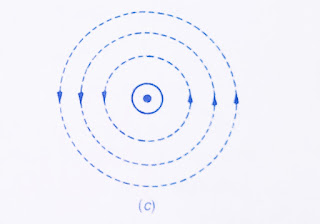How does a 3–Phase Induction Motor Work ?
Generally speaking , let us consider one conductor on the stationary rotor.
 |
| Stationary rotor |
Let, this conductor be subject to the rotating magnetic field produced when a three-phase supply is connected to the three-phase winding of the stator.
Let, the rotation of the magnetic field be clockwise. A magnetic field moving clockwise has the same effect as a conductor moving anticlockwise in a stationary field.
By Faraday's law of electromagnetic induction, a voltage will be induced in the conductor. Since the rotor circuit is complete, either through the end ring or an external resistance the induced voltage causes a current to flow in the rotor conductor. By right-hand rule we can determine the direction of induced current in the conductor.
Since the magnetic field is rotating clockwise, and the conductor is stationary we can assume that the conductor is in motion in the anticlockwise direction with respect to the magnetic field. By right-hand rule the direction of the induced current is outwards ( shown by for ). Shown in fig below :
The current in the rotor conductor produces its own magnetic field. Shown in fig below :
 |
| Producing a magnetic field surrounding the rotor conductor |
We know that when a conductor carrying current is put in a magnetic field a force is produced on it. Thus, a force is produced on the rotor conductor. The direction of this force can be found by left-hand rule. Shown in fig below :
It is seen that the force acting on the conductor is in the same direction as the direction of the rotating magnetic field. Since the rotor conductor is in a slot on the circumference of the rotor, this force acts in a tangential direction to the rotor and develops a torque on the rotor. Similar torques are produced on all the rotor conductors.
Since the rotor is free to move, it starts rotating in the same direction as the rotating magnetic field. Thus, a three-phase induction motor is self-starting. Since the operation of this motor depends upon the induced voltage in its rotor conductors, it is called an INDUCTION MOTOR.
Speed And Slip of 3-Phase Induction Motor :
An induction motor can't run at synchronous speed. Let us consider for a moment that is rotor is rotating at synchronous speed. Under this condition, there would be no cutting of flux by the rotor conductors, and there would be no generated voltage, no current and no torque.
The rotor speed is therefore slightly less than the synchronous speed. An induction motor may also be called as 'Asynshronous motor' as it doesn't run at synchronous speed. The difference between the synchronous speed and the actual rotor speed is called the Slip speed.
The "Slip speed" expresses the speed of the rotor relative to the field.
If, Ns = synchronous speed in r.p.m.
Nr = actual rotor speed in r.p.m.
The slip speed = Ns – Nr r.p.m.
The slip speed expressed as a fraction of the synchronous speed is called the per-unit slip or fractional slip. The per-unit slip is usually called the slip. It is denoted by s.
s ∆= Ns – Nr ÷ Ns per unit (p.u.)
Percentage slip = Ns – Nr ÷ Ns × 100
Alternatively if
ns = synchronous speed in r.p.m.
nr = actual rotor speed in r.p.m.
Then, s∆ = ns – nr ÷ ns p.u.
and percentage slip = ns – nr ÷ ns × 100
Also, s = ωs – ωr ÷ ωs
The slip at full load varies from about 5% for small motors to about 2% for large motors.




Please do not enter any spam link in the comment box. ConversionConversion EmoticonEmoticon